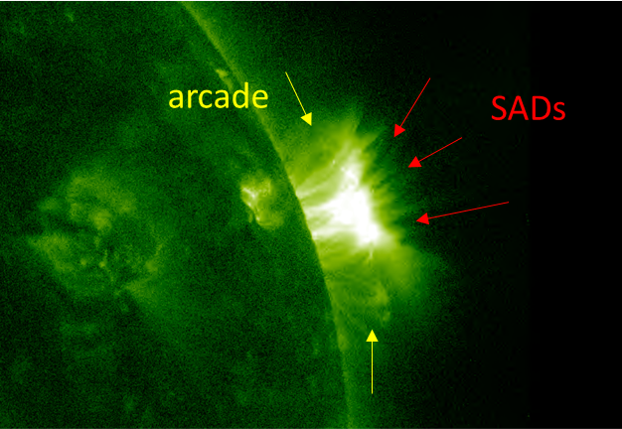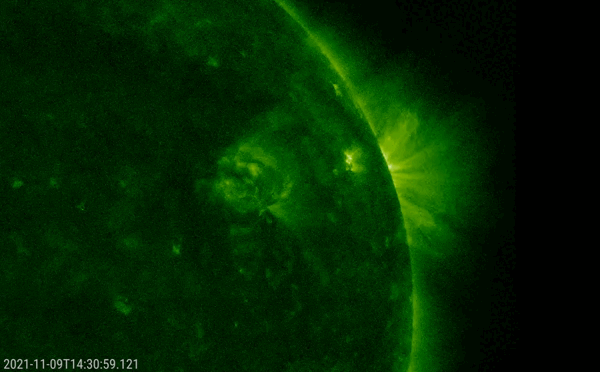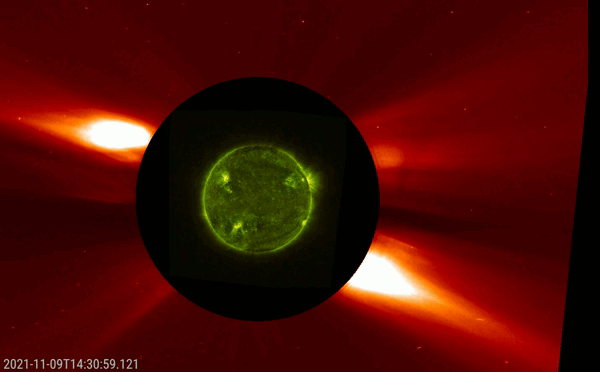NOAA 2891 was responsible for various M- and C-class flares while transiting the solar disk from 26 October till 7 November. It also was the source of the fast coronal mass ejection (CME) which resulted in the strong geomagnetic storm of 3-4 November (see this STCE Newsitem). The region was spotless and significantly less flare-active when it rounded the northwest limb late on 7 November. So it came a little bit as a surprize when a long duration M2 flare from what was likely Region 2891's location was observed on 9 November (peak at 17:02UT). This was an energetic eruption, slightly enhancing the greater then 10 MeV proton flux at geosynchronous orbits to 2.6 pfu, but remaining well below the alert threshold of 10 pfu. The eruption was also accompanied by a fast CME (900 km/s) which was -in view of the source location- not directed to Earth.


The above extreme ultraviolet (EUV) imagery of the flaring event (SDO/AIA 094) reveals the presence of so-called supra-arcade downflows (SADs) which were for the first time observed on 20 January 1999 by the Soft X-ray Telescope (SXT) on Yohkoh. They are dark voids that usually flow downwards above post-flare loops during the decay phase of the flare (McKenzie & Hudson 1999). Hence their name: supra ("above") arcade (= series of post-flare loops) downflows. Because of their appearance, they are often also called "tadpoles". See the annotated image above as well as this STCE Newsitem for another example.
With the launch of the Solar Dynamics Observatory (SDO), SADs were observed more frequently by the higher temperature EUV channels such as AIA131 or AIA094 which are sensitive to high temperatures plasma of several million to about 10 million degrees. SADs are thought to play an important role in the release of flare energy, with their temperature generally lower than that of the surrounding structures. The velocity of SADs ranges from a few tens to hundreds of km/s (no typo!), but no matter what velocities the SADs have, they finally stop at the flare loop top, and the rate of deceleration, while uncertain, appears to be consistent with drag. Several models have been proposed to explain the formation of SADs (see e.g. Li et al. 2021 for a discussion). One of the more recent models was proposed by Xue et al. (2020), who directly explained the formation of SADs by stating that the patchy and bursty magnetic reconnection outflows may push away surrounding plasma and leave dark lanes behind them. The magnetic field may play an important role in inhibiting plasma mixing and preventing SADs from being filled by ambient plasma immediately. Considering there are plenty of other models proposed, the last word on the formation of SADs is certainly not said.
In the composition underneath, the SDO/AIA 094 (green) imagery is overlaid with the PROBA2/SWAP wide-field EUV imagery (yellow) on top of the LASCO/C2 coronagraphic imagery. It shows the fast, non earth-directed CME that was associated with this energetic event. Note, in the clip, the continued patchy outflow once the CME has left the coronagraph's field-of-view.






